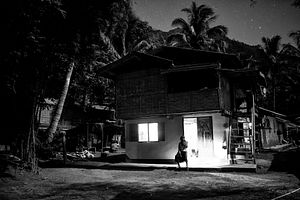Luc Forsyth and Gareth Bright have set out on a journey to follow the Mekong river from sea to source, The Diplomat will be sharing some of the stories they’ve found along the way. For more about the project, check out the whole series here.
After a long boat ride from Luang Prabang, we reach the village of Khoc Kham to learn about innovative electrical solutions and the impacts of an increasingly globalized world on remote communities.
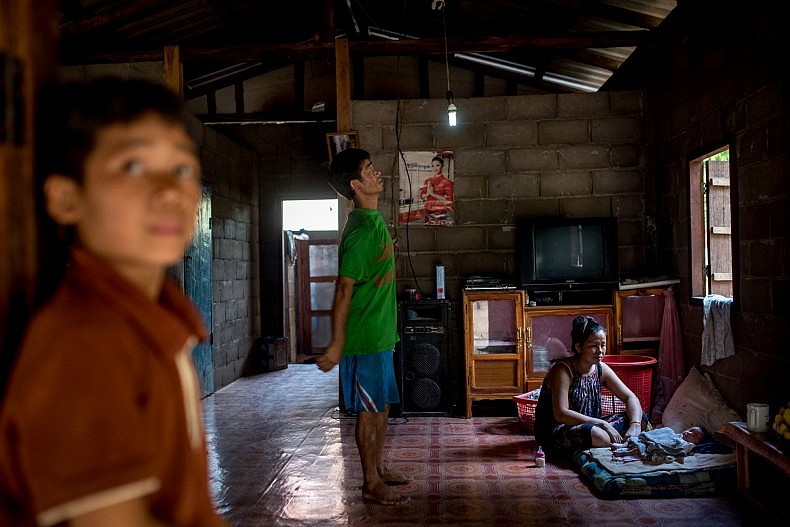
A family home in the the village of Khoc Khom. Photo by Luc Forsyth.
When the light turned on in Si Tach’s living room, the whole family paused what they were doing to watch the process. As he screwed in the bulb and the blueish light flickered and then lit the space, there was a general feeling of relief mixed with little bit of wonder at the magic of technology. Over the four days that we spent in Khoc Kham village, each time this process was repeated the mood was the same.
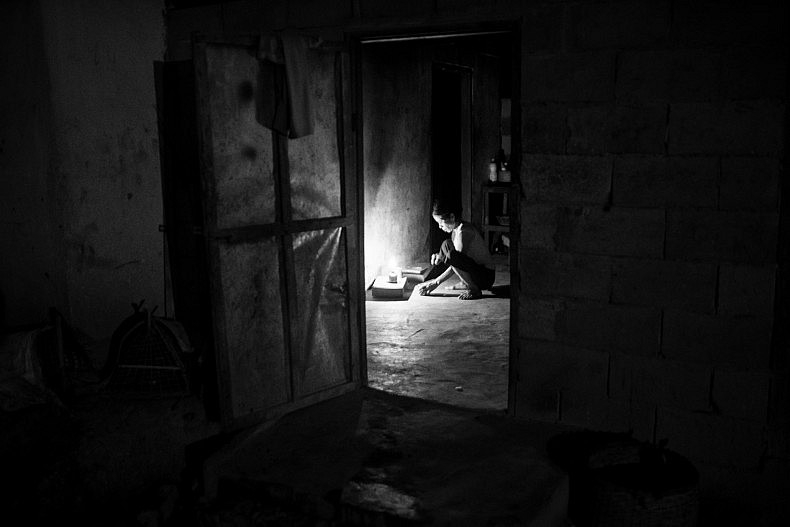
The village is not connected to the main electrical grid and many residents operate their own turbines to power lights and sometimes small appliances. Photo by Gareth Bright.
It wasn’t that Si Tach and his family were members of some un-contacted hill tribe who were seeing electric lighting for the first time. They’d had power in the village for nearly a decade by the time we came to visit. But unlike Laotians living in cities who could simply flick a switch without much reason to think about where the current came from, the people in this remote mountain village had built their power grid from scratch and cared for it in the same way a farmer does his crops – constantly and attentively.
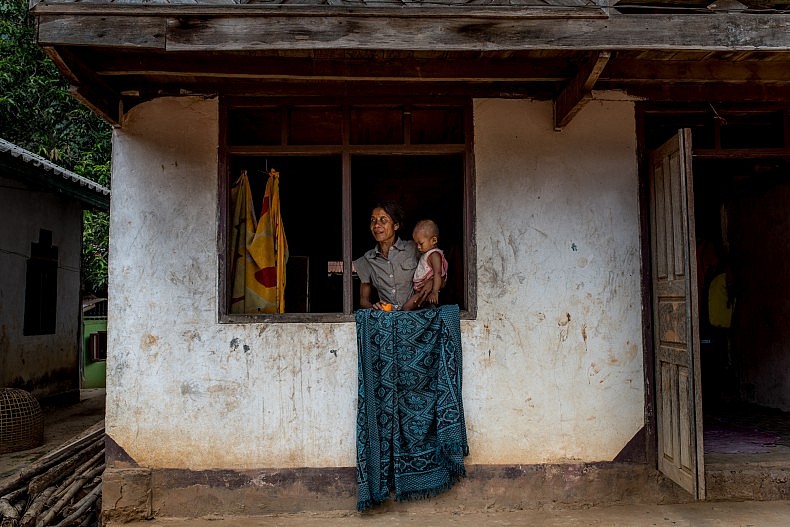
A woman and her baby in the village of Khoc Kham. Photo by Luc Forsyth.
With our time in Laos drawing to a close, we had traveled 2 hours up the Mekong by boat to reach Khoc Kham, hoping to gain some insight into the relationship between Laos’ remote communities and electricity. As the country works to transform itself into the battery of Southeast Asia, exporting power generated from the Mekong and its tributaries to its wealthier neighbors, we wanted to know what that meant for people like Si Tach who lived on the fringes of modernity.
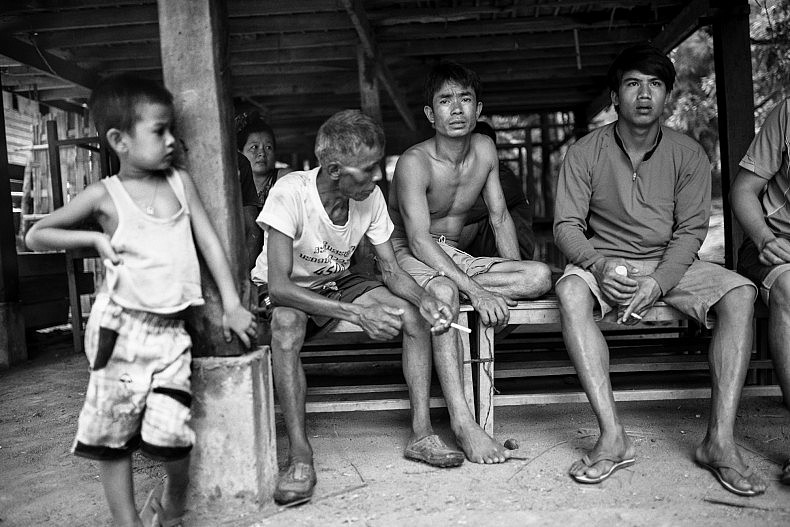
Group of men living in the village of Khoc Kham. Photo by Gareth Bright.
These were people who hunted with slingshots and homemade muskets and hadn’t experienced electric light bulbs until well into the 21st century. Were they benefiting from the damming of the national waterways, either financially or in terms of infrastructure? How was the rush to develop natural resources affecting their traditional ways of life? What did the future hold for such communities?
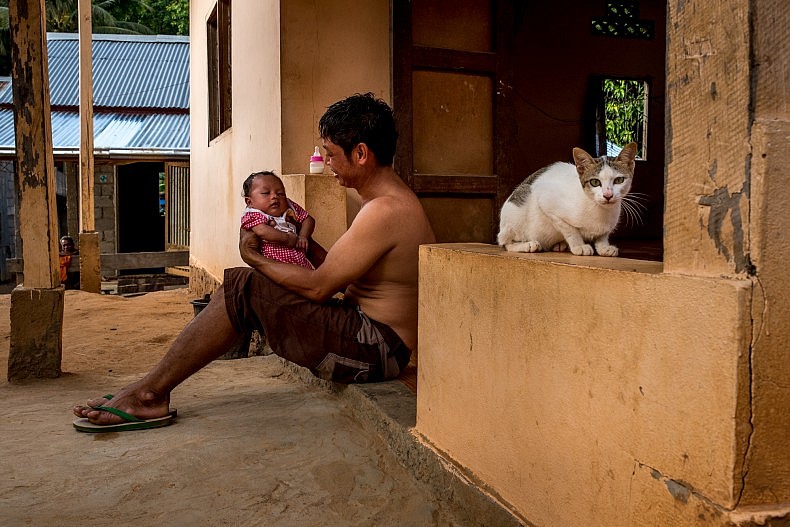
A man with his newborn baby in the village of Khoc Kham. Photo by Luc Forsyth.
Let There Be Light
“The first time I heard about this technology was from the people in the next village,” Si Tach told us in his living room after screwing in the single lightbulb. As there were still several hours of daylight left, the act seemed to serve more to prove to us that it worked than to provide needed light. “Before we used to use oil lamps, which were hard to see by. Now some of us can even watch TV.”
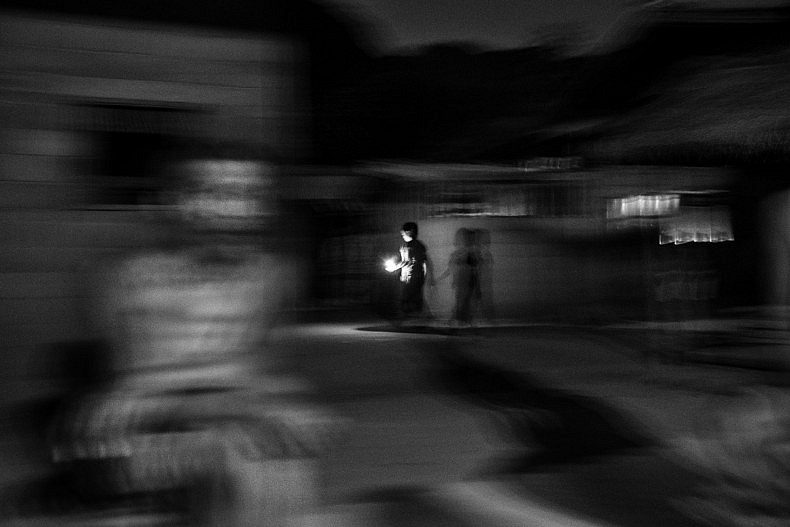
“Before we used to use oil lamps, which were hard to see by. Now some of us can even watch TV,” Si Tach said. Photo by Gareth Bright.
Considering there was not a single road or even a dirt path connecting Khoc Kham to Luang Prabang (the nearest city), the ability to read by electric light – let alone watch the news – was no small luxury.
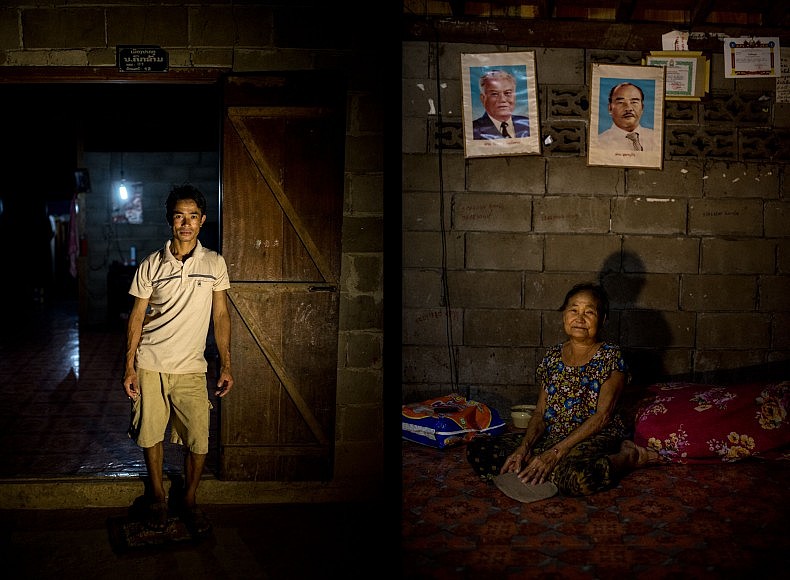
Left: Si Tach Ponmachak, 35, stands in front of his house, lit by a single LED bulb.
Right: Sao Pou, 70, sits under the portraits of two of Laos’ most revered former politicians.
Photos by Luc Forsyth.
Removing the bulb from its socket and wrapping it in a protective piece of cloth, Si Tach gestured for us to follow him. Only a few minutes had passed since we’d arrived in the village and sat down in his house, but already a sizeable group of villagers had gathered. With Si Tach in the lead and us trailing behind, the entire crowd set off along a jungle trail towards the sound of running water somewhere in the valley below. Twenty minutes later we were standing on the banks of a small but swiftly flowing creek.
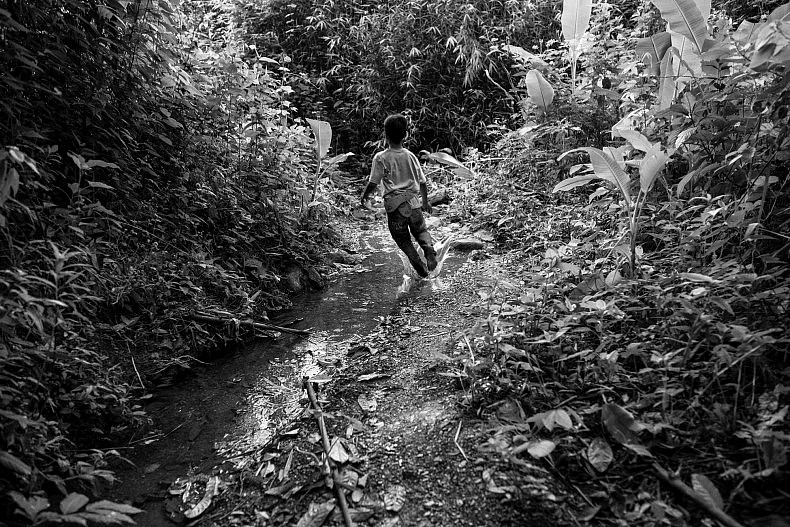
A boy runs by a creek outside the village of Khoc Kham. Photo by Gareth Bright.
“I’m not sure where the idea came from,” Si Tach said by way of explanation, perhaps sensing that we didn’t fully understand what we were looking at. “The people in the next village said they heard it from the people in the village next to them, and those people said they learned it from the next village, and so on.”
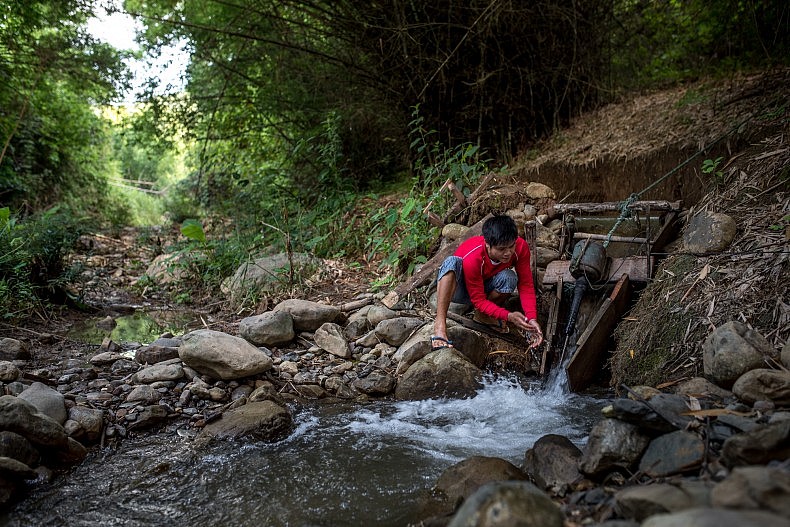
A man checks on his families water turbine in the village of Khoc Kham. Photo by Luc Forsyth.
Wherever the idea came from, it was a deceptively clever way of generating power with a minimum of technology. A single propeller spun in the current of the stream, which turned a long metal shaft that was connected to a small generator. In essence it was a boat engine working backwards.
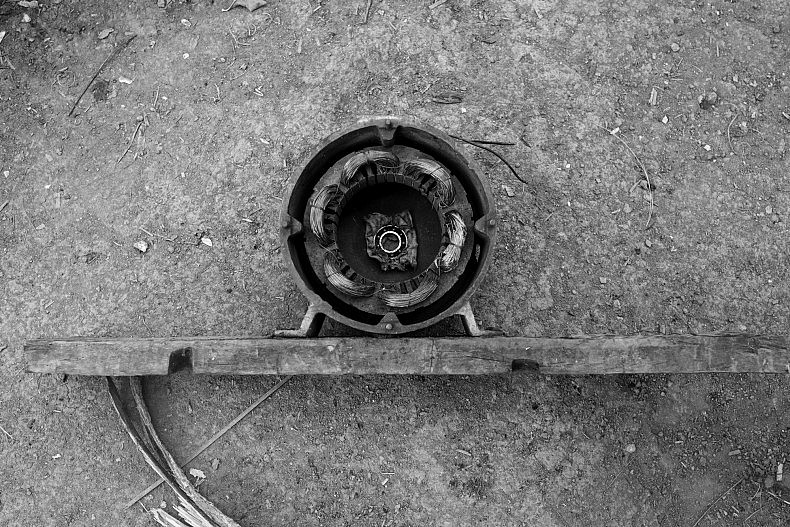
The village of Khoc Kham’s power comes down to a single propeller. Photo by Gareth Bright.
“At first there was only one of these in the village, and it was shared between two families,” Si Tach said. “People used to come to us and rent single lightbulbs for their houses and we would charge by the month. Now [ten years later] most families have their own.”
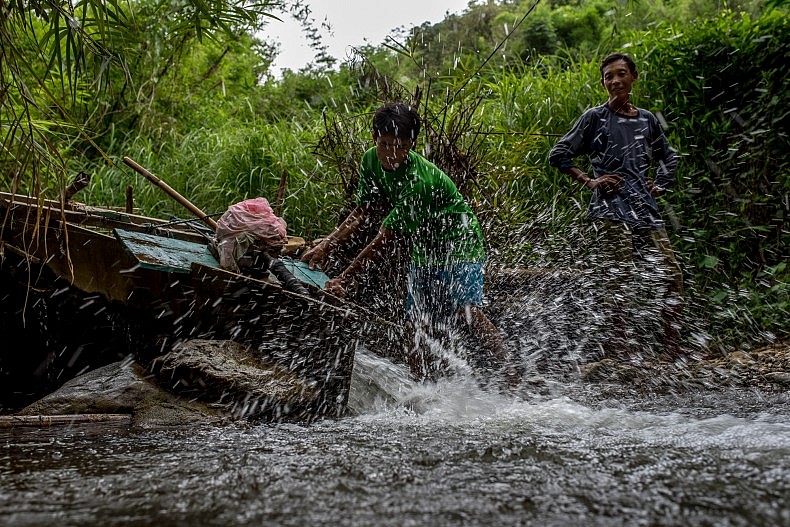
A man turns on his water turbine as evening approaches in the village of Khoc Kham. Photo by Luc Forsyth.
As night fell, the extent to which the generators had impacted life in Khoc Kham became apparent. A blue-tinted glow shone through the doorways and window cracks of nearly every home, and groups gathered under the bare bulbs. While the lights had made night time socializing a more pleasant experience, it was in the village’s cottage economy that the power of electricity was most felt.
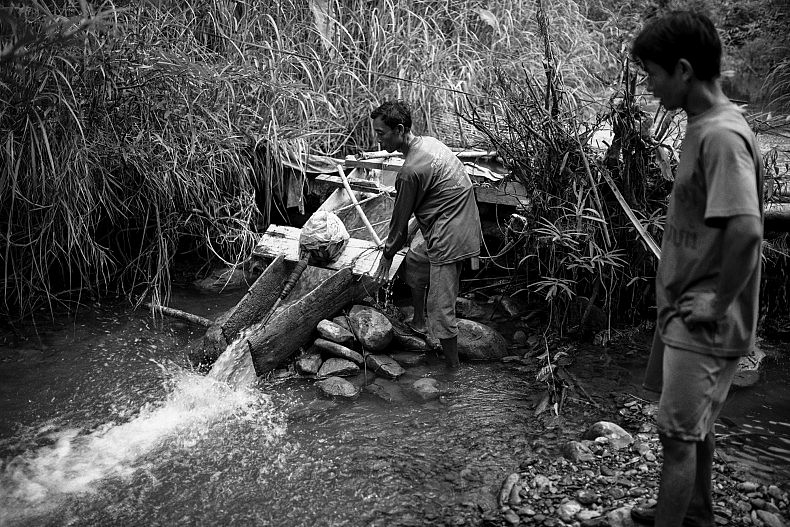
Men gather around the village’s source of electricity. Photo by Gareth Bright.
“2-3 years ago I was using a lamp,” 57-year-old That Mee said, sitting cross legged on the floor of his one room home. “These lights have made a big difference. We make bamboo baskets to sell, and now it is possible to work at night.”
Xieng Pai, a 54-year-old shopkeeper who lived around the corner echoed what Mee had said. “Having lights makes it possible to count money at night, so I can keep my shop open,” he said, in a tone that let us know how obvious and silly he thought our line of questioning was. And he was right, it was obvious: life was easier with lights.
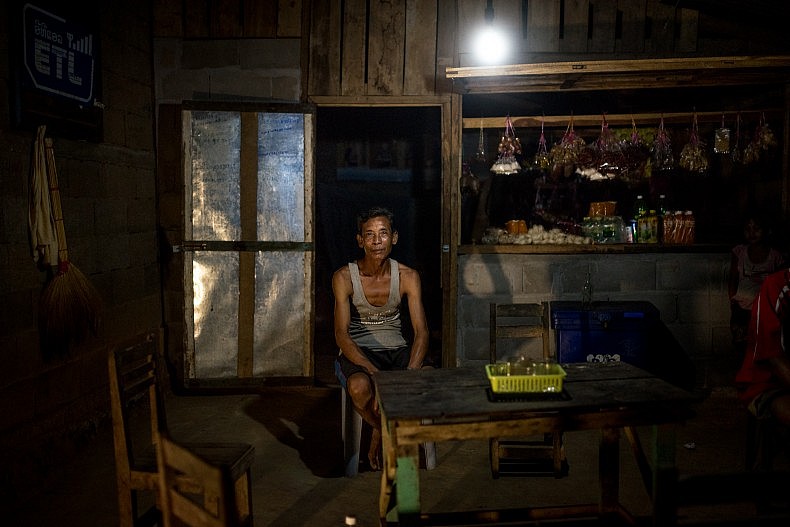
Xieng Pai, 54, is a shopkeeper in the village of Khoc Kham. He powers the light in his shop using a portable water turbine. Photo by Luc Forsyth.
The World Approaches
Waking on the floor of Si Tach’s living room under an expansive white mosquito net, the sounds and smells of cooking enticed us into movement. The breakfast spread, while an incredibly thoughtful gesture, was eclectic to say the least. Next to the usual fried meats and woven baskets of sticky rice we had come to love during our time in Laos was a selection of what must have represented all the imported foods available in the village. A tin of sardines in tomato sauce, bowls of Chinese instant noodles, a tube of Oreo cookies, packets of instant coffee mix, and several bottles of Mountain Dew.

A light shines from inside a house in the village of Khoc Kham. Photo by Gareth Bright.
Beyond making for a strange flavor combination, the meal reminded us that Khoc Kham did not have much interaction with the outside world. We were just the third group of non-Laotian outsiders to visit the village in living memory after a school-building missionary group and a team of Vietnamese engineers who had constructed their own concrete house in the village to use as a base of operations while they scouted the area for suitable dam-building locations. But we also knew that the outside world was coming to them whether they wanted it to or not. Once Mountain Dew appeared, the hydropower survey teams could not be far behind.
Outside, another indicator of the approaching global economy greeted us in the form of a truly bizarre spectacle. Somehow during the previous night, a boatload of plastic animal masks had arrived in Khoc Kham and seemingly every child in the village had adopted the cartoon faces of rabbits and tigers.
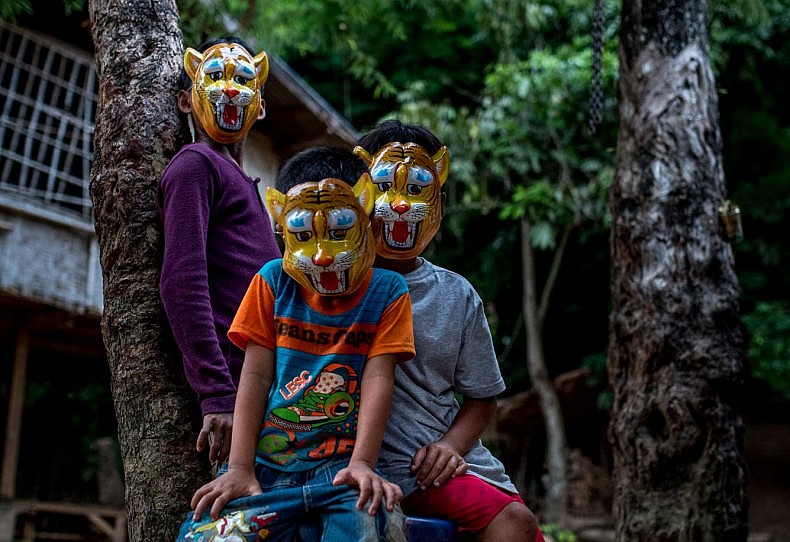
Children wear plastic masks in the village of Khoc Kham. With the introduction of affordable outboard motors, the villagers, who have no road access to the outside world, can trade with nearby villages. Photo by Luc Forsyth.
“Before we were separated from the outside world and people just lived for themselves,” Si Tach said in explanation, sensing our confusion at the strange menagerie running through Khoc Kham’s dirt roads. “Now with the help of boat engines, we are connected to bigger villages that we can trade with.”
When we followed up by asking if he worried about the future of his community as it became more and more connected his answer took us off guard, though given what we’d seen already in Laos, perhaps it shouldn’t have. “Oh yes, we are very worried. When the dam is built we will have no choice, we will have to move,” he said. We had come to Khoc Kham to learn about electricity in remote communities; we hadn’t even known a dam was being built in the area.
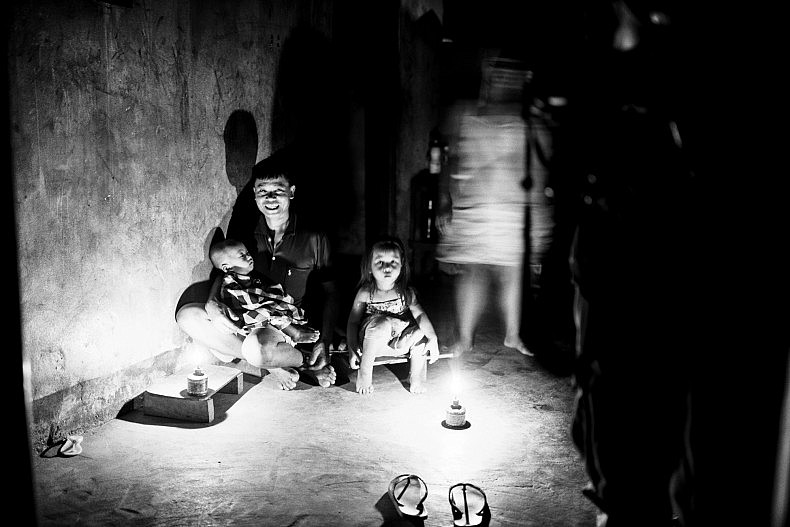
Villagers in Khoc Kham gather around a light powered by their own electricity generation system. Photo by Gareth Bright.
“We’ve been living here so long, everything is here,” Si Tach continued. “When we move, we will have to start over.”
This piece originally appeared at A River’s Tail.













